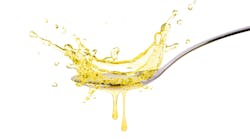Oil pulling originated in India as a holistic, Ayurvedic medicinal practice dating as far back as 3,000–5,000 years. It was believed that oils derived from either sunflower, palm, sesame, or coconut had the ability to extract harmful toxins from the bloodstream and reduce systemic inflammation.1,2 Traditional Ayurvedic remedies involve the use of herbs and spices to address the condition and understand the root cause of any problem.3
Currently, many patients are seeking holistic options for treatment recommendations and are electing to have natural ingredients in their oral health-care products. Although a holistic approach to care is one that many dental professionals practice when considering oral-systemic wellness, evidence behind the true benefits of oil pulling is limited. When evaluating for periodontal disease, the microbial environment, caries incidence, and host inflammatory response are all clinical parameters that dental professionals consider. Despite limited statistically significant evidence on the oral health benefits of oil pulling, various studies have been conducted outlining its potential therapeutic effects and how it could be pivotal in areas where oral hygiene resources are minimal. This article aims to objectively review the most current research on this practice.
You may also be interested in ... Oil pulling: Yes, no, or maybe?
What is oil pulling and how does it work?
Oil pulling involves vigorous swishing of one tablespoon of oil between the teeth ideally for 15–20 minutes three times per day, starting in the morning.2 Typical oils used are sesame, coconut, palm, or sunflower. The therapeutic benefits of oil pulling are believed to include reducing systemic inflammation, relieving dry mouth, soothing chapped lips, whitening teeth, reducing halitosis, reducing plaque, and improving oral hygiene.3
Coconut oil and palm oil are composed mainly of triglycerides. Through lipolysis, the process of breaking down lipids into energy, triglycerides in the oils are broken down into free fatty acids and monoglycerides.1 The main fatty acid composition of virgin coconut oil is lauric acid, which studies have shown may have antimicrobial properties.1 Additional by-products of the lipolysis of oil include monolaurin and other monoglycerides. These by-products may play a role in altering bacterial cell walls, disrupting membranes, and inhibiting enzymes required for energy production and nutrient transfer, leading to bacterial cell death.1 However, how much lipolysis activity occurs in the mouth and how much lipase is available in the saliva can vary among patients, potentially altering the therapeutic benefits of coconut oil.1
Sesame oil is another product used for oil pulling because it does not stain and has no aftertaste, but it isn't necessarily cost-effective compared to over-the-counter mouth rinses.4 This oil in particular possesses antioxidative properties that support the action of vitamin E.2 Studies have investigated sesame oil and its possible therapeutic benefits; however, no statistically or clinically significant evidence has been definitively proven.
Therapeutic benefits of oil pulling
The true mechanism of action and oral health benefits of oil pulling are unclear, but several studies have pointed to a few theories.2,3 It has been postulated that oil pulling may improve the water-repellent abilities of the lipid-enriched pellicle that forms on the tooth surface. This increase in hydrophobicity may prevent bacteria from collecting and biofilm from subsequently adhering to the tooth surface.1,2
Oil is very viscous and when swished for a period of time, it takes on the consistency of soap. This saponification, or “soap making” process involves combining fat into bicarbonate ions that are normally found in the saliva and which play a crucial role in pH buffering.3,4 When soap mixes with oil, the surface area is increased, which expands the oil’s cleansing ability.3
Oils also possess antioxidant properties that cause detoxification by preventing lipid peroxidation, a process that can lead to membrane rupture and cell death. This process acts as an antibiotic by enhancing the effects of vitamin E in the mouth.2,3
Other studies have looked at coconut oil as an antifungal and its abilities to kill yeast and eliminate candida pathogens in the oral cavity, but there has been no statistically significant evidence to support this hypothesis.2,4
Variations between study parameters and participants—such as length of time one is required to swish with oil, how frequent oil pulling is to be completed, restrictions on oral hygiene care, types of oil used, and study duration—contribute to conflicting study results.5
A recent meta-analysis performed a systematic quantitative analysis on published randomized, controlled trials to determine the effects of oil pulling on oral health.3 Clinical markers that were evaluated in this study included reduction in Streptococcus mutans count, reduction in salivary bacterial colony count, and improvements in both gingival and plaque indices. Of the studies evaluated, no statistically significant difference was found in S. mutans reduction with oil pulling compared to the control group.3
Despite these results, some studies have shown that oil pulling can reduce caries risk from marked to mild or moderate. On the contrary, there was a statistically significant reduction in salivary bacterial count with oil pulling versus the control group.3 When analyzing the effect of oil pulling on gingival and plaque indices, the studies conducted did not yield any statistically significant difference when comparing oil pulling to the control group.3 Many studies produce results that could propose benefits in reduction of microbial load and caries incidence; however, further studies must be conducted to establish objectively significant differences.5
Practice guidelines and patient recommendations
When it comes to practice guidelines and recommendations to provide patients regarding oil pulling practices, there are some things to consider in addition to the aforementioned research. Until more research evolves, there is a lack of clinical parameters around the practice of oil pulling, and patients need to be made aware of this information.2
Oil pulling is popular because there are no strict precautions to follow the regimen—other than that children under the age of 5 should not use it due to risks of swallowing.2 Elderly adults and those at risk for aspiration should also be cautious about using oil pulling as a few cases of exogenous lipid pneumonia have pointed to fatty substances being introduced into the airway when swallowed or aspirated, leading to an inflammatory reaction.5
Oil pulling does have possible benefits in inflammation and plaque reduction, so in public health cases where access to oral hygiene aids may be limited, or if patients are purely looking for a holistic anti-inflammatory option, oil pulling could be a practice to consider.5
Conclusion
The process of oil pulling has existed for many years, yet studies present conflicting information regarding its benefits due to variations in study parameters. Sesame oil and coconut oil are two products that have shown possible therapeutic benefits, but many studies present with high bias and lack of statistical significance.
In holistic medicine, oil pulling has demonstrated systemic health benefits. With more rigorous research and consistent study parameters, the oral health benefits of oil pulling may become better understood and accepted in mainstream oral health care.5 Currently, oil pulling does not have any side effects and is easy to use, so it can certainly be an adjunctive to a patient’s oral hygiene routine if they choose. However, patients should understand the limited research supporting this practice. Oral health-care professionals can remain optimistic that conducting additional studies will help further develop and guide the practice of oil pulling.
Editor's note: This article appeared in the July 2024 print edition of RDH magazine. Dental hygienists in North America are eligible for a complimentary print subscription. Sign up here.
References
- Siripaiboonpong N, Matangkasombut O, Pengcharoen H, Boonchaiyapluk B, Rujiraprasert P, Srithanyarat SS. Microbiological effects of virgin coconut oil pulling in comparison with palm oil pulling as an adjunctive oral hygiene care for patients with gingival inflammation: a randomized controlled trial. J Indian Soc Periodontol. 2022;26(1): 58-63. doi:10.4103/jisp.jisp_768_20
- Naseem M, Khiyani MF, Nauma H, Zafar MS, Shah AH, Khalil HS. Oil pulling and importance of traditional medicine in oral health maintenance. Int J Health Sci (Qassim). 2017;11(4): 65-70.
- Peng TR, Cheng HY, Wu TW, Nj BK. Effectiveness of oil pulling for improving oral health: a meta-analysis. Healthcare (Basel). 2022;10(10):1991. doi:10.3390/healthcare10101991
- Raja BK, Devi K. Oral health effects of oil pulling: a systematic review of randomized controlled trials. J Indian Assoc Public Health Dent. 2021;19(3):170-179. doi:10.4103/jiaphd.jiaphd_8_21
- Jong FJX, Ooi DJ, Teoh SL. The effect of oil pulling in comparison with chlorhexidine and other mouthwash interventions in promoting oral health: a systematic review and meta-analysis. Int J Dent Hyg. 2024;22(1):78-94. doi:10.1111/idh.12725







